
The Mark 42 was the standard USA single 5" (12.7 cm) gun mount of the post World War II-era. Developed as a replacement for the 5"/38 (12.7 cm) twin mount, it used a more powerful round and fired as fast as both guns in that older mount combined. The gun was developed from the 5"/38 (12.7 cm) Mark 12 and the 5"/54 (12.7 cm) Mark 16 and shared similar features such as the vertically sliding breech block and the interrupted-screw (bayonet joint) barrel mounting. This weapon is alternatively fed from right and left ammunition drums. These are independent systems feeding a single breech and barrel, effectively creating 1.5 guns.
Most Mark 42 mounts originally had two "frog-eye" local fire control domes, one on each side. The one on the right was for anti-aircraft and the one on the left was for surface firing. Many of the AA domes were removed in the 1960-70s as local control against high-speed aircraft was considered to be nearly impossible.
During the Vietnam War, the Mark 42 developed a reputation for jamming during protracted firing due to the complex nature of the loading mechanism. Slowing the rate of fire greatly reduced the problem. Later upgrades increased the rate of fire, but not as high as the original figure.
This weapon is fairly heavy and manpower intensive, both defects in a weapon of only secondary importance on a missile ship. Although later mods reduced the manning requirement down from 20 to 12 crewmen, this is still higher than the newer and more automated 5" (12.7 cm) Mark 45 mount.
Nomenclature Note: In the late 1940s, the USA changed from designating guns by the gun itself over to designating by the gun mounting. Mark 42 is actually the gun mount designation, the designation of the gun itself is 5-in/54 (12.7 cm) Mark 18.
| Designation | 5"/54 (12.7 cm) Mark 18 (Gun) 1 5"/54 (12.7 cm) Mark 42 (Mount) |
|---|---|
| Ship Class Used On | First used on USS Northampton CLC-1
Many US warships 1950s to 1980s Exported to Japan where they were used on many DD and DDG warships Australia: Perth class DDG Spain: Baleares class frigates |
| Date Of Design | About 1950 |
| Date In Service | 1954 |
| Gun Weight (tube and liner) | 5,662 lbs. (2,550 kg) |
| Gun Length oa | N/A |
| Bore and Barrel Length | 270.0 in (6.858 m) |
| Rifling Length | 229.07 in (5.820 m) |
| Grooves | N/A |
| Twist | Uniform RH 1 in 25 |
| Chamber Volume | 825.38 in3 (13.525 dm3) |
| Rate Of Fire | As designed: 40 rounds per minute in automatic mode
Derated after 1968: 28 rounds per minute With the latest alterations:
|
- ^The Mark 18 differed from the earlier 5"/54 Mark 16 by having a 21 inch (53.3 cm) longer slide cylinder and a modified band seat.
| Type | Separate |
|---|---|
| Projectile Types and Weights 1a | HC Mark 41 Mod 0 with PD fuze - 69.33 lbs. (31.448 kg)
HC Mark 41 Mod 0 with MT fuze - 69.45 lbs. (31.505 kg) HC Mark 41 Mod 0 with VT fuze - 69.19 lbs. (31.384 kg) SP Common Mark 42 Mods 0 and 1 2a - 70.0 lbs. (31.75 kg) Illum Mark 33 Mod 0 - 70.0 lbs. (31.75 kg) Illum Mark 48 Mod 0 - 69.2 lbs. (31.39 kg) RAP Mark 58 3a - 70.0 lbs. (31.75 kg) |
| Bursting Charge 4a | HC Mark 41 - 7.75 lbs. (3.515 kg) Explosive D or Composition A-3 or PBX
SP Common Mark 42 Mods 0 and 1 - 2.14 lbs. (0.97 kg) Explosive D RAP - 3.8 lbs. (1.7 kg) Explosive D |
| Projectile Length | 26.0 in (66 cm) |
| Cartridge Case Type, Size and Empty Weight | Mark 6 - Brass, 127 x 836 mm, 13.04 lbs. (5.91 kg)
Mark 7 - Brass, 127 x 836 mm, 13.04 lbs. (5.91 kg) |
| Propellant Charge | 18.5 lbs. (8.19 kg) SPD or SPDN
19.0 lbs. (8.62 kg) SPDF |
| Muzzle Velocity | 2,650 fps (808 mps) |
| Working Pressure | 18.5 tons/in2 (29,137 kg/cm2) |
| Approximate Barrel Life | 3,070 Rounds |
| Ammunition stowage per gun | Mitscher: 350 rounds
Farragut: 560 rounds Belknap: 600 rounds Knox: 600 rounds Others: N/A |
- ^In addition to the types listed in this table, a laser-guided shell known as "Deadeye" was developed primarily for shore bombardment. However, this program was canceled in 1989.
- ^Special Common Mark 42 had a windscreen and a thin hood and was strengthened to enhance its armor piercing qualities. Mark 41 projectile bodies could be used with Point Detonating (PD), Mechanical Time (MT) or with proximity (VT) nose fuzes. When used with PD fuzes, they were considered to be HC rounds while those with MT and VT fuzes were considered as AA rounds. Rounds with MT or PD nose fuzes had an instantaneous contact type base fuze. A blind plug was used in place of the base fuze for those projectiles using VT nose fuzes.
- ^The Rocket Assisted Projectile (RAP) Mark 58 was developed during the 1960s. The rocket motor burned for 34 seconds.
- ^Starting near the end of World War II some bursters were made from Composition A-3 (a granular explosive consisting of 91% RDX and 9% plasticizing wax) in order to provide a more potent AA projectile. This was a sensitive explosive which could suffer from adiabatic heating resulting from the compression of the explosive as the projectile was accelerated in the gun barrel. If the burster was loosely packed or had voids, then this heating could be great enough to create an in-bore explosion which would wrecked the gun barrel and cause other damage. Between 1965 and 1969 the U.S. Navy fired about 2,891,000 rounds of 5" (12.7 cm) ammunition and had six in-bore prematures and the Australian Navy experienced one in-bore detonation out of approximately 38,000 HC-PD Mark 41 Mod 0 5"/54 (12.7 cm) USN projectiles fired. These failures resulted in a USN program to investigate the use of castable PBX compositions in large caliber projectiles. Eventually, PBXN-106 was recommended for use in the Navy 5" (12.7 cm) projectiles.
- Misfires are semi-automatically removed.
- The illumination round burns for approximately 50 seconds.
- Bourrelet diameter was 4.985 inches (12.66 cm).
| Elevation | Range | Angle of Fall | Time of Flight | Striking Velocity | Maximum Ordinate |
|---|---|---|---|---|---|
| 1.92 degrees | 4,000 yards (3,658 m) | 2.17 degrees | 5.10 seconds | 2,088 fps (636 mps) | 104 ft (32 m) |
| 3.01 degrees | 6,000 yards (5,486 m) | 3.88 degrees | 8.18 seconds | 1,826 fps (557 mps) | 269 ft (82 m) |
| 4.53 degrees | 8,000 yards (7,315 m) | 6.28 degrees | 11.73 seconds | 1,587 fps (484 mps) | 553 ft (169 m) |
| 6.29 degrees | 10,000 yards (9,144 m) | 9.62 degrees | 15.84 seconds | 1,375 fps (419 mps) | 1,010 ft (308 m) |
| 8.46 degrees | 12,000 yards (10,972 m) | 9.62 degrees | 20.60 seconds | 1,205 fps (367 mps) | 1,715 ft (523 m) |
| 11.14 degrees | 14,000 yards (12,802 m) | 19.97 degrees | 26.07 seconds | 1,095 fps (334 mps) | 2,770 ft (844 m) |
| 14.38 degrees | 16,000 yards (14,630 m) | 26.45 degrees | 32.14 seconds | 1,060 fps (323 mps) | 4,275 ft (1,303 m) |
| 18.18 degrees | 18,000 yards (16,459 m) | 32.85 degrees | 38.71 seconds | 1,057 fps (322 mps) | 6,305 ft (1,922 m) |
| 22.62 degrees | 20,000 yards (18,288 m) | 39.23 degrees | 45.88 seconds | 1,068 fps (326 mps) | 8,970 ft (2,734 m) |
| 24.12 degrees | 24,000 yards (21,946 m) | 51.90 degrees | 63.49 seconds | 1,107 fps (337 mps) | 17,120 ft (5,218 m) |
| 47.40 degrees | 25,909 yards (23,691 m) | 62.47 degrees | 82.49 seconds | 1,148 fps (350 mps) | 28,000 ft (8,534 m) |
| 58.93 degrees | 24,000 yards (21,946 m) | 70.03 degrees | 96.70 seconds | 1,186 fps (361 mps) | 37,680 ft (11,485 m) |
| 85.00 degrees | N/A | N/A | N/A | N/A | 51,600 ft (15,728 m) |
- ^Values from BuOrd OP 1188 page 16 and "Naval Weapons of World War Two" page 143.
- Range of RAP round is not available but was probably about 30,000 yards (27,400 m).
| Designation 1c 2c | Single Mounting - Mark 42
USA: Northampton (4), Mitscher (2), Forrest Sherman (3), Charles F. Adams (2), Farragut (1), Belknap (1), Truxton (1), Knox (1) and Forrestal (8) Japan: Tachikaze (2), Takatsuki (1), Shirane (2) and Haruna (2) Australia: Perth (2) Spain: Baleares (1) |
|---|---|
| Weight | Mod 9 and Mod 10
Fully loaded: 145,930 lbs. (66,193 kg) Without ammunition and fluids: 129,159 lbs. (58,586 kg) Other Mods: N/A |
| Elevation | -15 / +85 degrees |
| Elevation Rate | 25 degrees per second |
| Train | about +150 / -150 degrees |
| Train Rate | 40 degrees per second |
| Gun recoil | 18.75 in (47.6 cm) |
| Loading Angle | Any |
- ^The Mark 42 Gun Mount was produced in 10 different Mods. Mods 1 through 6 were the first mounts to enter service and were used on USS Northampton (CLC-1) and DL-2 through DL-5. The Forest Sherman (DD-931) class were originally equipped with Mods 7 and 8. The Mod 8 mount had a radar system integrated into the mount which was never really successful. The radars were removed at the first overhaul and the mounts reverted to a Mod 7 designation. Mod 7 saw extensive service during the Vietnam War and was found to have serious sustainability problems. BuOrd initiated a "Gunnery Improvement Program" which resulted in the much improved Mod 10. The Mod 9 mounts were first introduced on the Knox (FF-1052) class frigates and were a lighter design using all solid-state electronics. Mod 9 was also exported to Spain. Only two men were needed in the gunhouse in this Mod versus four for the Mod 7. The Mod 7 had superior acceleration over the Mod 9, 60 degrees per second2 for the Mod 7 versus 40 degrees per second2 for the Mod 9. The Mod 10 mounts were an upgrade of the Mod 7 mount and entered service in 1970's. Mods 9 to 12 were lighter and had lower manning requirements, falling from 20 men in the original Mod 0 down to 13 for Mod 9 and to 12 in Mod 10 (gun captain and 11 crewmen).
- ^Forrest Sherman class destroyers modified into missile ships lost both of their aft 5"/54 (12.7 cm) guns. Other members lost No. 2 gun and their 3"/50 (7.62 cm) guns in order to fit an ASROC launcher. USS Northampton (CLC-1) lost three of her 5"/54 (12.7 cm) guns by the time she was decommissioned in January 1970. Forrestal class carriers lost their four forward 5"/54 (12.7 cm) guns in the early 1960s as it was found that their sponsons slowed the ship down in rough seas. The after guns followed in the 1970s, with USS Ranger CVA-61 being the last active carrier to carry 5"/54 (12.7 cm) guns until her last pair were removed in 1977.
- The gun in all mods is fed by two loader drums which each hold twenty rounds of ammunition.
- This mounting operates from 440 Vac 60 Hz three phase.
- This mounting consists of two component groups: The lower structure (below deck) and the upper structure (above deck). Lower structure components include parallel two-stage hoist/loader drum arrangements that deliver an uninterrupted flow of ammunition to the gun. Upper structure components load the ammunition, aim the gun, fire the ammunition and eject the empty powder cases. The lower structure was originally produced by the US Navy Naval Ordnance Station in Louisville, Kentucky. The two ammunition loading systems in the lower component group feed the gun alternatively. Each system has a cartridge drum and a projectile drum, with each drum holding twenty units of ammunition. The drums usually rotate together, but the shell drum can rotate independently of the cartridge drum, which allows different ammunition to be selected during the loading cycle. The projectile and cartridge are mated when they leave their respective drums and the complete round moves from the lower to the upper hoist and then to the upper hoist and finally to the a cradle which swung up to throw it into a transfer tray from which it is rammed into the breech. The only manual element of this system is the placing of the cartridges and projectiles into the loading drums.
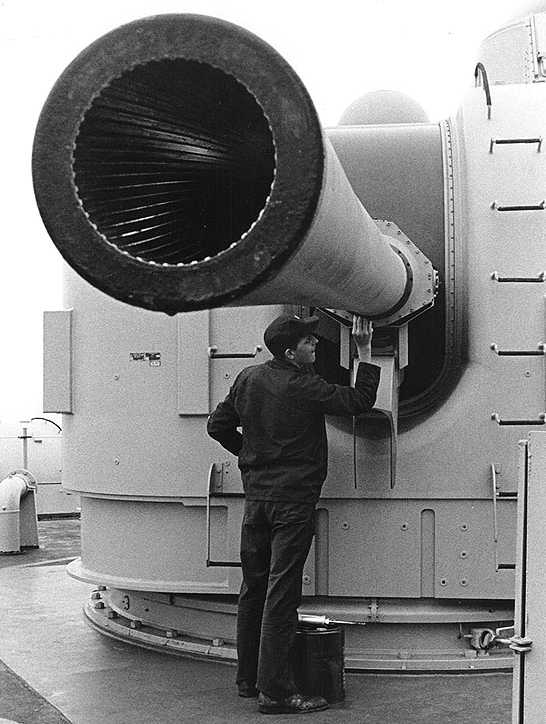


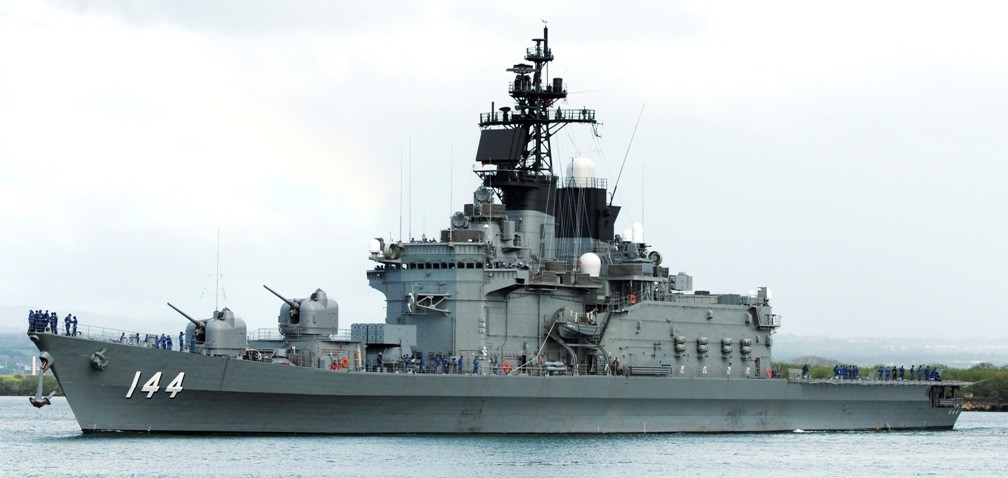

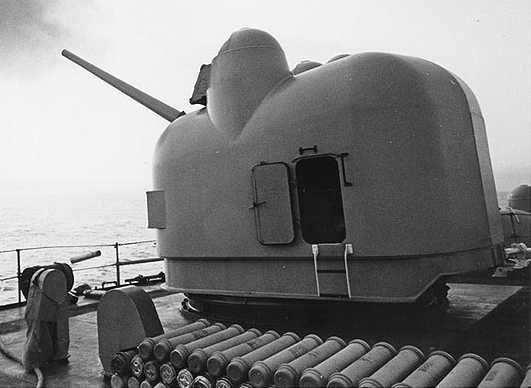
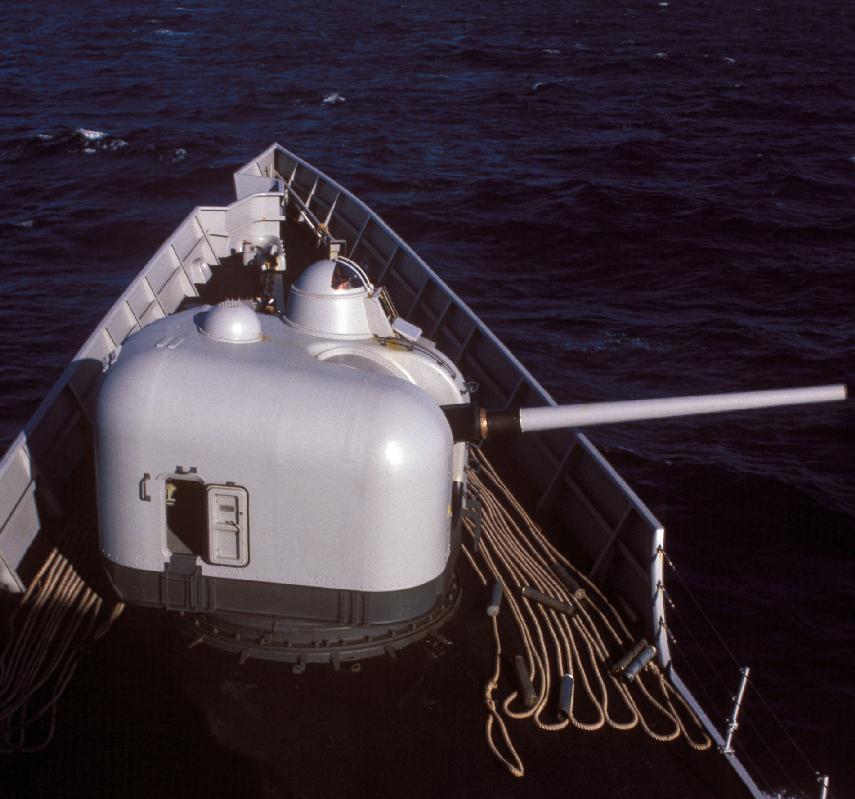
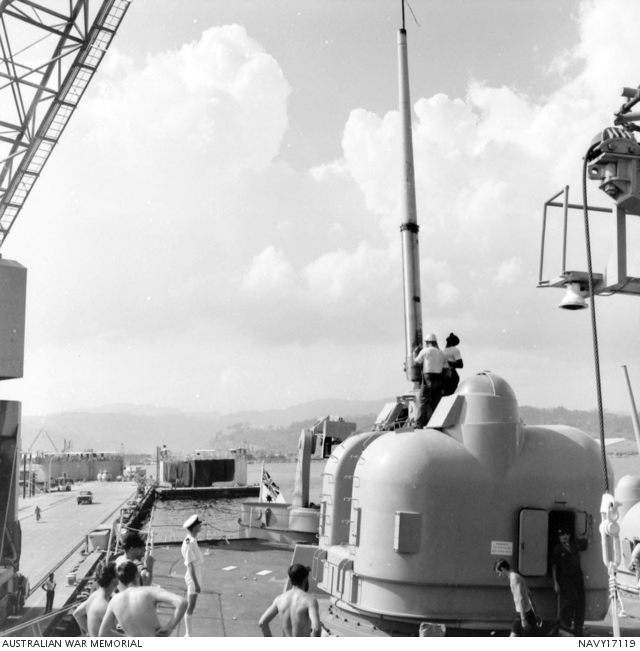
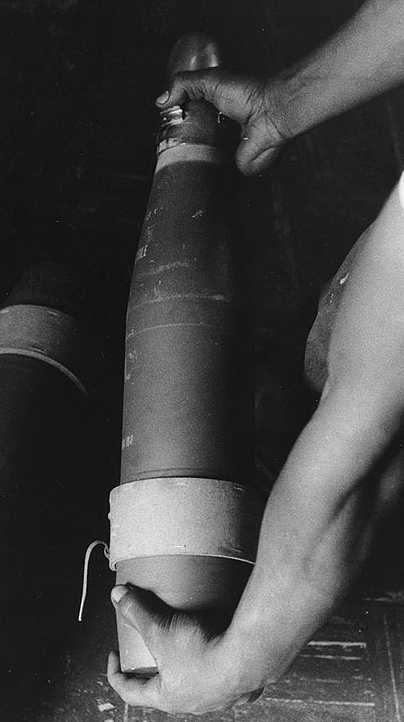
Note the grommet protecting the driving band and that the round is boat-tailed. U.S. Navy Photograph No. 1143901.
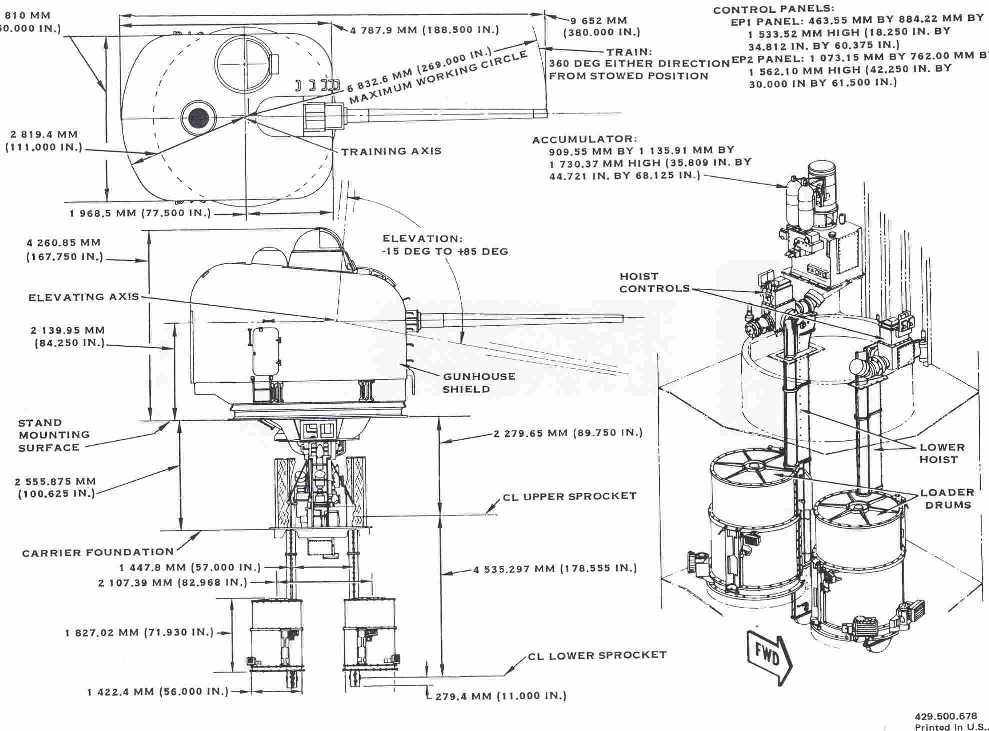
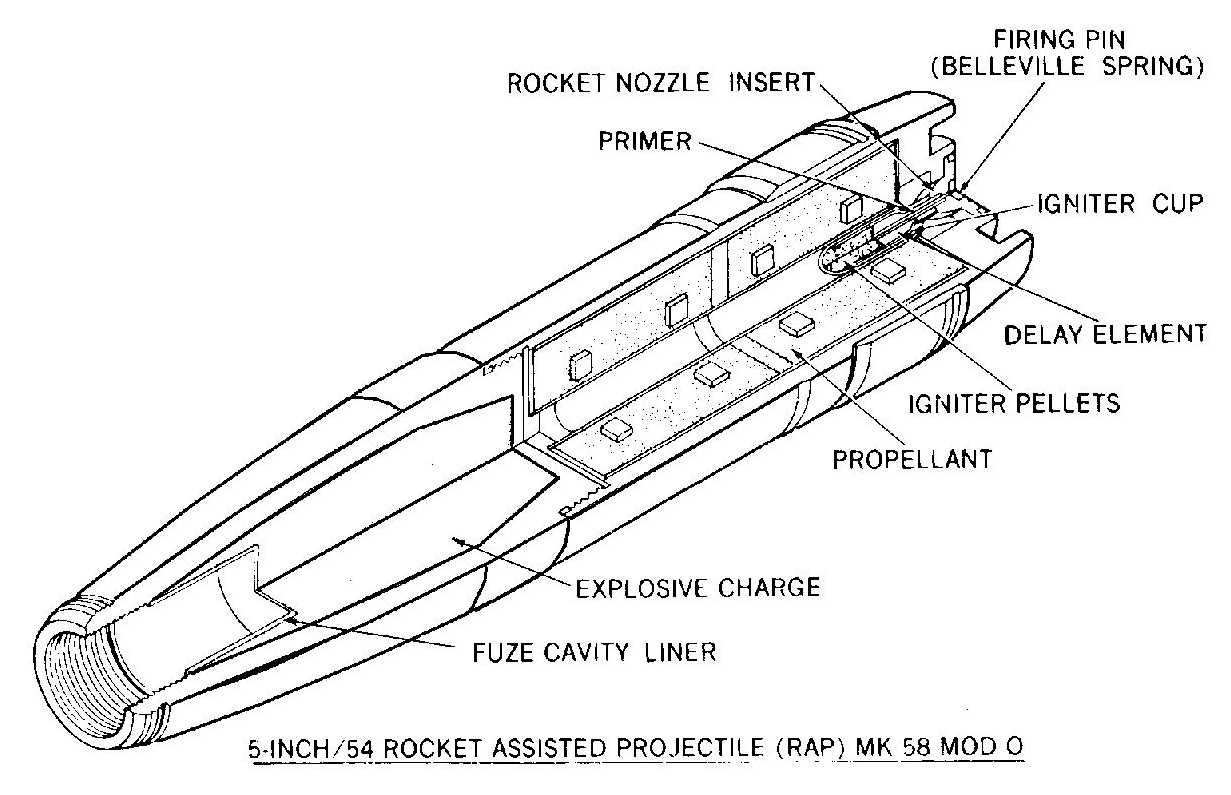

"Jane's Pocket Book 9: Naval Armament" edited by Denis Archer
"The History of Insensitive Munitions" by Raymond L. Beauregard
"Aircraft Carriers of the World, 1914 to the Present: An Illustrated Encyclopedia" by Roger Chesneau
"Dahlgren" by Kenneth G. McCollum, Editor
"US Destroyers: An Illustrated Design History," "US Cruisers: An Illustrated Design History,"
"US Naval Weapons" and "The Naval Institute Guide to World Naval Weapon Systems 1991/92" all by Norman Friedman
---
"U.S. Explosive Ordnance: Ordnance Pamphlet 1664 - May 1947" by Department of the Navy
---
United Defense Press Releases
---
Special help from Leo Fischer
02 February 2008 - Benchmark
15 June 2010 - Added picture of RAP
05 September 2011 - Added ammunition stowage and mounting information
22 January 2012 - Added picture of Kurama
08 March 2015 - Added note regarding bore prematures
23 July 2015 - Corrected typographical error
03 August 2016 - Converted to HTML 5 format
28 February 2018 - Reorganized notes
12 May 2019 - Added photograph of HMAS Hobart
07 August 2019 - Added detail to Composition A-3 note
07 August 2021 - Added comment regarding Gunnery Improvement Program and reorganized notes
14 August 2023 - Revised range table
